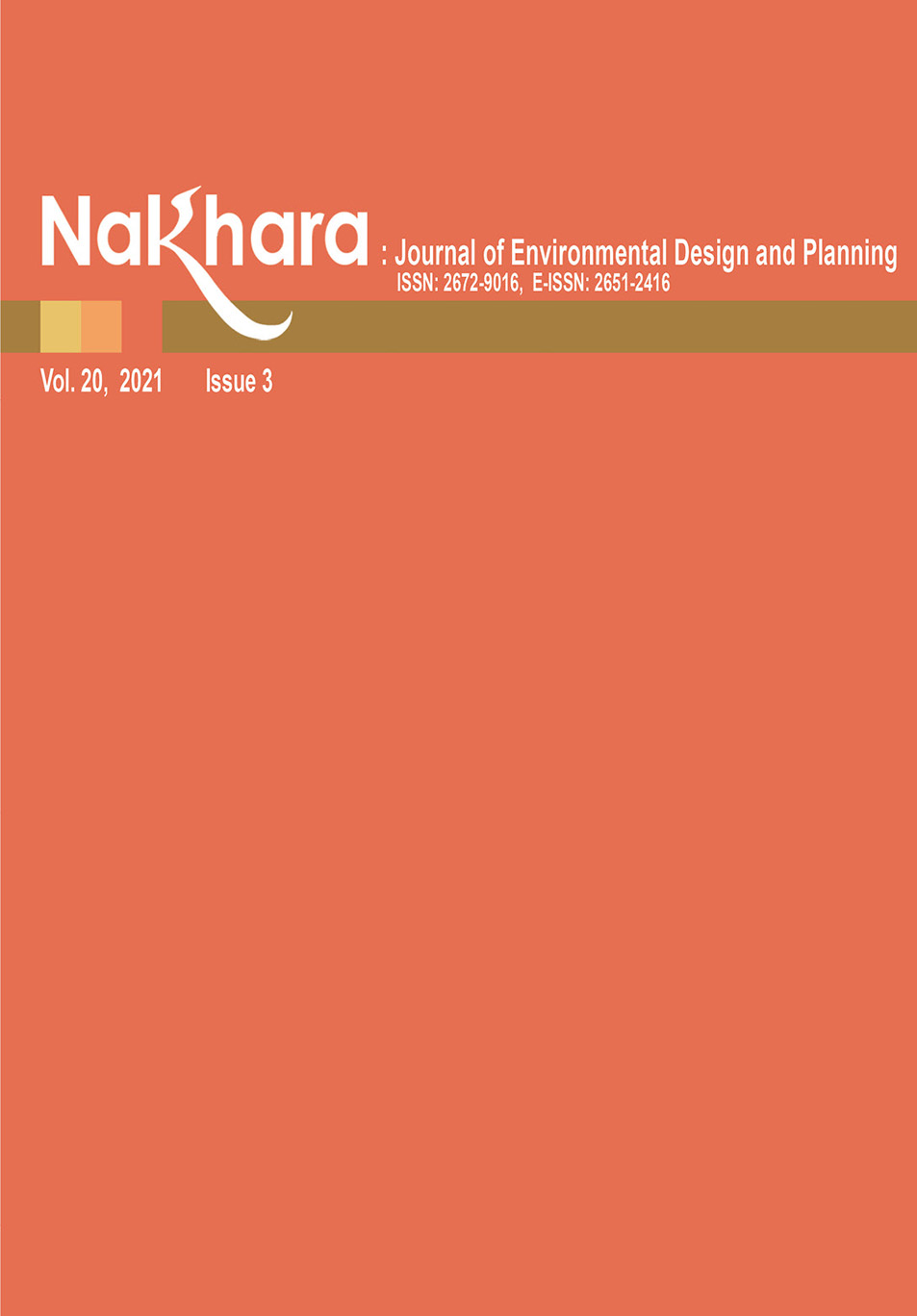Green Infrastructure Development in Urban Areas: Case Studies of Samutsakhon, Krathumbaen and Banphaeo Municipalities in Samut Sakhon Province
Main Article Content
Abstract
Though the development of green infrastructure in parks in Samut Sakhon province has been continuously implemented, there are still no research studies that have explicitly demonstrated the parks’ potential, nor any public opinions toward the development of urban green infrastructure in the parks that would be productive for the planning to efficiently improve and provide urban green infrastructure. As a result, this study had the following objectives: 1) To analyze the potential and networks of urban green infrastructure in parks in Samut Sakhon province, 2) To analyze the satisfaction of using the services and requirements of the urban green infrastructure development in the parks in Samut Sakhon province, and 3) To propose development guidelines in urban green infrastructure for the parks of Samut Sakhon province. The research instruments comprised a questionnaire, and the data were analyzed by using a scalogram. The results found that high-potential parks were not large in size, but they had all the complete components, as well as green infrastructure featured in the attributes of patch, matrix, and mosaic. Nevertheless, the green infrastructure development featured in the attribute of the corridor had disappeared in several sites of the green infrastructure in the parks. Likewise, the green networks of the parks, specifically those in the high-potential category, were not successive by walking. For this reason, the people were mostly satisfied with the convenient accessibility of the parks, but there were the requirements of paving the footpath, improving the landscape, and adding a variety of activities in the parks. Therefore, the development guidelines of urban green infrastructure in the parks should formulate more areas in the attribute of the corridor at the riverside and on the streets, conserve and increase the park areas by allowing public participation in the management, as well as apply urban planning measures to obtain the park area. In addition, a footpath and bike lane should be safely constructed in the high-potential parks. Simultaneously, the landscape should be adjusted in the low- and moderate-potential parks by launching pilot projects in the parks of the governmental agencies.
Article Details

This work is licensed under a Creative Commons Attribution-NonCommercial-NoDerivatives 4.0 International License.
References
Beveridge, C.E. (n.d.). Olmsted—his essential theory. National Association for Olmsted Parks. https://www.olmsted.org/the-olmsted-legacy/olmsted-theory-and-design-principles/olmsted-his-essential-theory
Calthorpe, P. (1993). The next American Metropolis: Ecology, community, and the American dream. Princeton Architectural Press.
Cohen, J.M., & Uphoff, N.T. (1977). Rural development participation: Concept and measures for project design implementation and evaluation. Rural Development Committee, Center for International Studies, Cornell University.
Department of Environment, Bangkok Metropolitan Administration. (n.d.). 7 types of green spaces. http://203.155.220.118/userfiles/files/park%20type.pdf
Department of Industrial Works. (2021). Industrial factory statistics. http://reg3.diw.go.th/webdiw/static-fac/
Department of Public Works and Town & Country Planning. (2006). The comprehensive plan criteria and standard B.E. 2549 (2006). Kurusapa Printing Press.
Forman, R. T., & Godron, M. (1986). Landscape ecology. John Wiley.
Gökyer, E. (2013). Understanding landscape structure using landscape metrics. IntechOpen. http://dx.doi.org/10.5772/55758
Hansen, R., Rall, E., Chapman, E., Rolf, W., & Pauleit, S. (2017). Urban green infrastructure planning: A guide for practitioners. GREEN SURGE. https://www.e-pages.dk/ku/1340/html5/
Horayangkura, V. (2006). Human behavior and environment: Behavioral basis for design and planning. (6th ed.). Chulalongkorn University Printing House.
Inchompoo, P. & Srithanyarat, S. (2017). Developing green network for Bangkok Metropolitan area. Academic Journal of Architecture, 2017(66), 99-120.
National Statistical Office. (2021). Table of statistical data from census/survey/provincial statistical report/special survey. http://smsakhon.old.nso.go.th/nso/project/search/index.jsp?province_id=40&fid=3
Office of the National Economic and Social Development Council. (2021). Gross regional and provincial product chain volume measures 2019 edition. https://www.nesdc.go.th/main.php?filename=gross_regional
Peerapun, W. (2013). Analytical techniques for regional and urban planning. (3rd ed.). Charansanitwong Printing Co. Ltd,.
Pujinda, P. (2007). Criticize the city. Chulalongkorn University Press.
Samut Sakhon Office of Public Works and Town & Country Planning. (2021). The ministerial regulation for Mueang Krathumbaen comprehensive plan, Samut Sakhon province B.E.2562 Enforcement. https://drive.google.com/file/d/10yGoeEJ1n0R5U7Gt4WB3V6pM7nc4Nn0n/view
Samut Sakhon Office of Public Works and Town & Country Planning. (2021). The ministerial regulation for Banphaeo Subdistrict comprehensive plan, Samut Sakhon province (No.2) B.E.2560 Enforcement. http://www.ratchakitcha.soc.go.th/DATA/PDF/2560/A/017/1.PDF
Samutsakhon Municipality. (2021). The local development plan B.E.2561-2565 (2018-2022). http://www.sakhoncity.go.th/site/index.php?option=com_content&view=article&id=353:2020-04-22-06-48-27&catid=16:2019-09-01-11-50-04&Itemid=18
Sanguthai, C. & Krisanaphan, A. (2018). Planning and management comprehensive plan by public participation: Case study of Pattaya city. Sarasatr academic journal, 2018(3), 404-420.
Steiner, F., Butler, K., & American Planning Association. (2007). Planning and urban design standards student edition. John Wiley & Son, Inc.
The University of Nottingham Ningbo China. (2015). Urban green infrastructure: For cities of developing countries (part of the ELITH project report documents). https://butters.no/wp-content/uploads/publications/2016.THAI%20language%20version%20Green%20Infrastructures.AC+CB.Mar%202016.pdf
Tontisirin, N. & Anantsuksomsri, S. (2020). Quantitative research methods and techniques in urban and regional planning. Thammasat University Press.
Vásquez Sánchez, S., Mahaek, E. & Lekagul, A. (2020). A framework of design criteria for elderly facilities using Maslow’s hierarchy of needs. Nakhara: Journal of Environmental Design and Planning, 2020(18), 97-116.

